Think " tropical" and your mind probably goes to a spot filled with sun, sand, warm water, soft breezes, lush greens and exotic flowers. It's an immediate vacation.
If you live in a tropical or subtropical climate, getting started is easy. The plants that define "tropical" — palms, bougainvillea, bromeliads, orchids — are a natural fit. If you live on the edges of these climates, places like the American South or Pacific Northwest, you may not be able to grow every tropical plant. But there are many you can grow, and many similar-looking plants that can fill in, especially if you take care to create warm and sheltering microclimates within your yard.
Even if you're in a cold climate, don't despair. A surprising number of plants can handle the cold while looking like they were imported directly from a tropical jungle. And if you really want those true tropical plants, consider a container garden that you can enjoy throughout the summer and bring indoors over the winter.
Fortunately, many of our favorite houseplants are landscaping plants in tropical climates, so your indoor garden will brighten your space while seeming completely at home.
No matter where you live, a few guidelines will help you create your own tropical landscape.
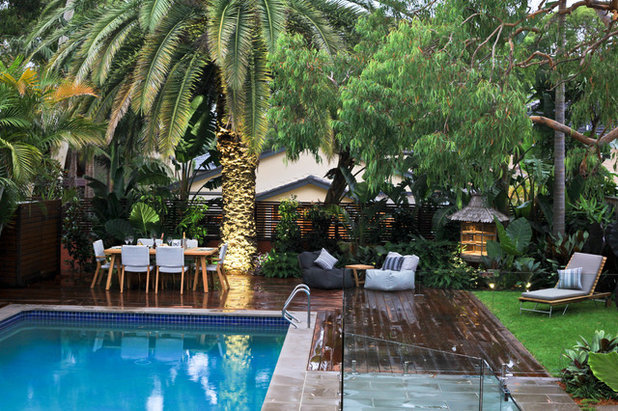
Impressions Landscape - Design
Plan how your tropical garden will fit into your overall landscape. It can envelop the entire yard and include all the amenities you'd find in a resort, as this space demonstrates. There's space for outdoor dining and relaxing, teaklike decking, a tropical-inspired accent piece, lighting that encourages you to stay outside throughout the evening, a mix of tropical plants and a stately palm shading the entire space.
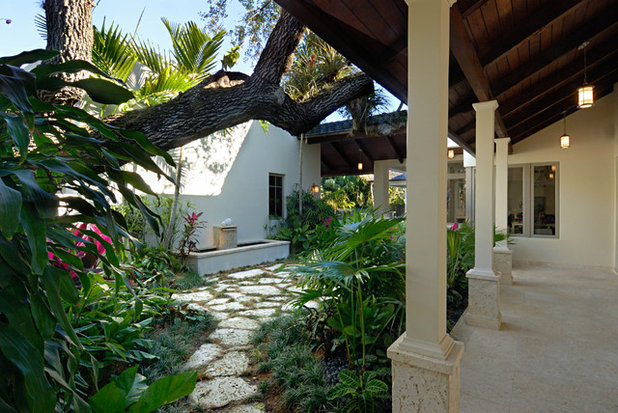
Torre Construction & Development
In a smaller area, you may need to cut back on the amenities — the pool becomes a fountain, the expansive deck is changed to a small path and a beam-topped patio. Even so, the landscape still reflects the same rich mix of plants that defines a tropical landscape.
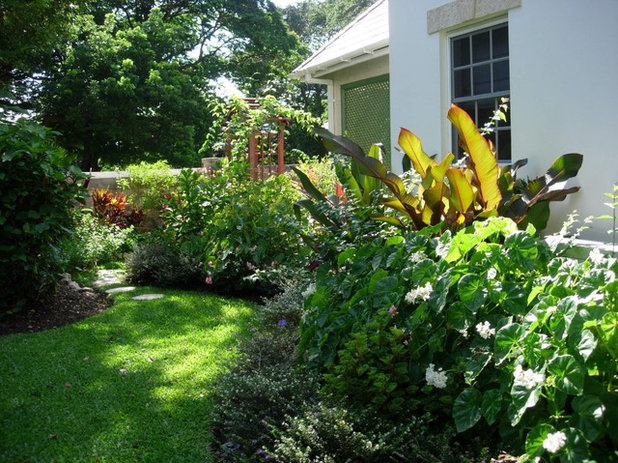
Home and Garden spaces
If your tropical landscape is only a part of your overall design, create a border alongside a house. It's a great choice for a sideyard, patio area, or border. It can blend into the rest of the space or be set apart as a separate garden room.
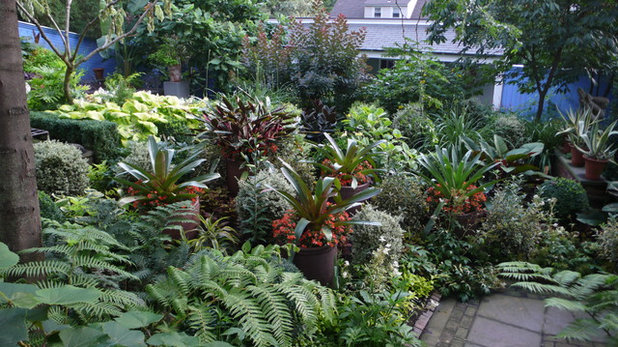 Lush foliage is essential.
Lush foliage is essential. A tropical garden is not the place for the plant collector who wants every plant to have its own spotlight position. Tropical gardens are filled with plants, overlapping one another, climbing on top of one another, filling in the space below and up high. Density is key.
Design tip: A sloped yard makes it easy to elevate plants so they can be seen while still maintaining the sense of a densely planted space. If your yard isn't sloped, use raised beds and pots at the back of the space to create that feeling.
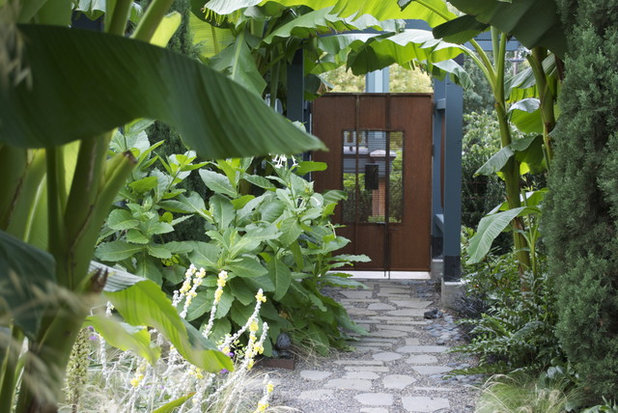
Lilyvilla Gardens
Palm leaves arching overhead shade this space whlie the shrubs below almost overtake the walkway, just as they would overtake a jungle path. The result is rich yet cool, a respite from the sun and a garden that invites you to explore what's past all the foliage.
Design tip: Adding vines to grow along a fence or even up a tree trunk will also contribute to the effect.
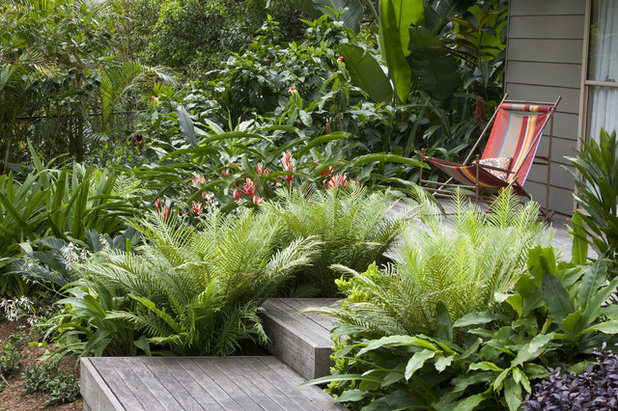
Secret Gardens
Ferns like these are ideal fillers in a tropical design. They not only add both structure and softness to the space, but the ferns will benefit from the shade provided by surrounding plants. Wooden steps to a beach chair overlooking the garden add a beachy touch to the scene.
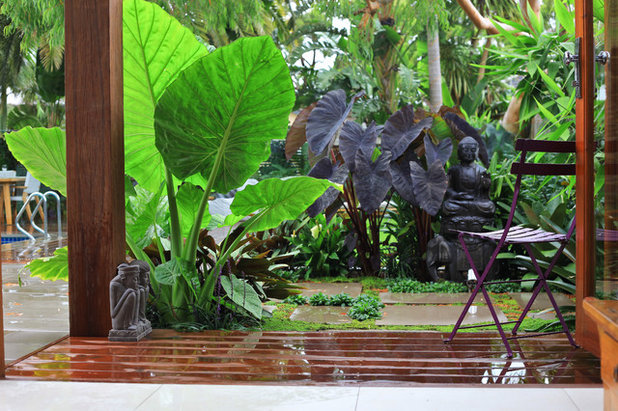
Impressions Landscape - Design
Big and bold is the norm for leaves. This is not Grandma's garden, unless of course Grandma lived in Bali. The leaves of tropical plants grow big and bold, and are known for their rich colors and distinctive shapes.
Design tip: Finding similar plants for cooler climates may be easier than you think. There are hardy bananas
(Musa sp.) available, and elephant's ear or taro
(Colcasia esculenta) can be grown as an annual.
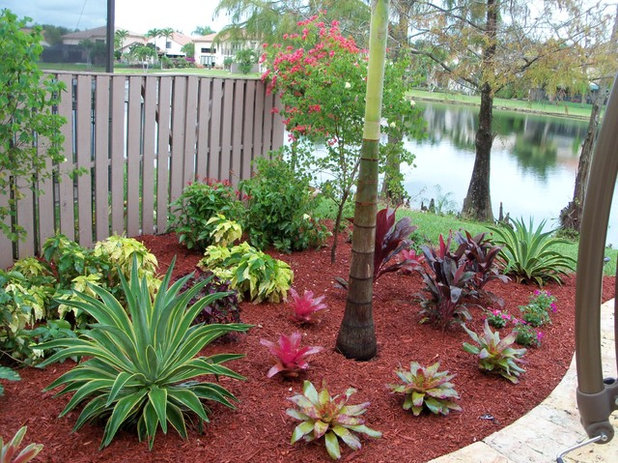
The Green Man Garden & Landscape
Even when small, tropical foliage is distinctive. Sharp-edged and spikelike win out over soft and fluffy, and a common leaf description may often include the word "leathery." It's meant in the best way: Leaves are thick and resilient.
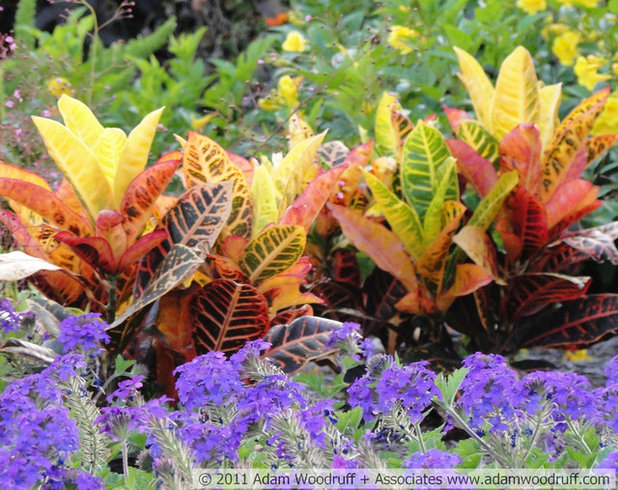
Adam Woodruff + Associates, Garden Artisans
A great option for gardeners anywhere is croton
(Codiaeum variegatum). These brightly colored plants, more familiar as houseplants, will thrive outdoors when it's warm enough. Simply bury the pots in the ground (or hide them amongst other plants) and bring these tough beauties indoors when the weather cools.
Design tip: This same trick also works well for other houseplants, such as coleus, dracaena and the always-popular
ficus
varieties.
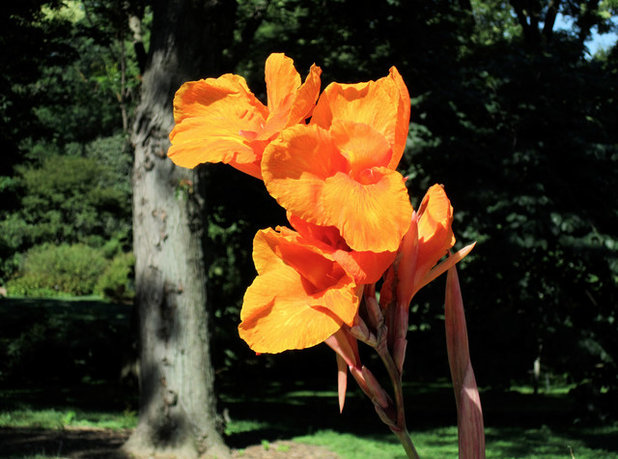
Brooklyn Botanic Garden
"Bright" and "exotic" define tropical flowers. From bird-of-paradise to hibiscus to heliconia, tropical flowers invite you to take a second look. One of the best tropicals for any garden is the canna, with its huge range of colorful flowers and leaves. Canna 'Pretoria' is both beautifully colored and readily available, but further exploration of the genus will open up a world of color for your garden.
Design tip: Don't overlook bromeliads and orchids. Though you may not overwinter them outside, they provide long-lasting blooms and are happy to come inside when it's cold.
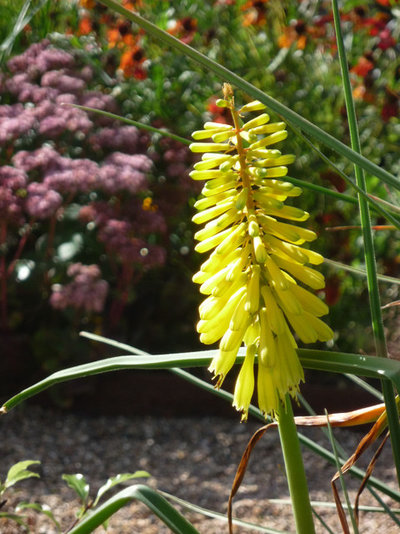
Fenton Roberts Garden Design
Kniphofia 'Brimstone', in an unusual shade of yellow-green rather than bright red of the plant commonly known as 'red-hot poker', will stand out even against the bright green of typical tropical foliage.
Design tip: Some common garden plants, such as impatiens and nasturtiums, are tropical plants at heart. You can find cold-tolerant varieties of hibiscus as well.
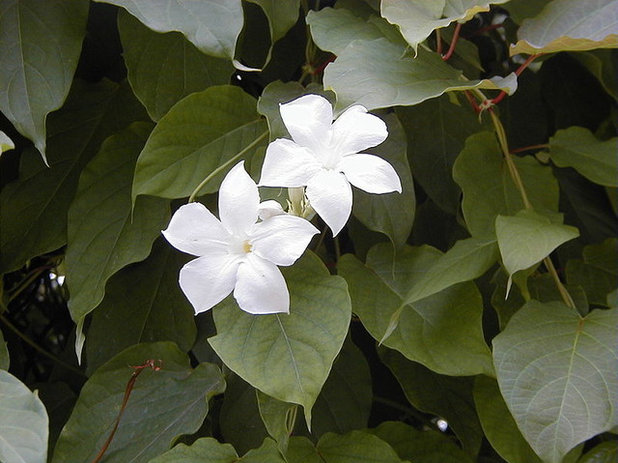
Don't forget to add vines. Mandevilla is increasingly popular and available, but morning glories, jasmine and the black-eyed Susan vine
(
Thunbergia alata, which can be grown as an annual) are other great choices.
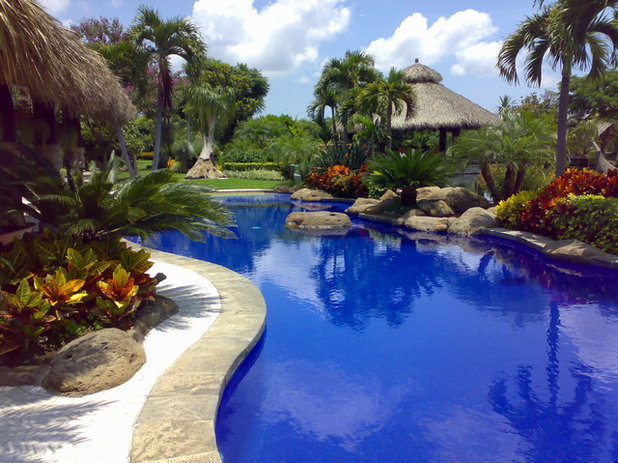
Mario Marquez
Next, add water. Every tropical garden needs some water, whether it's as small as a fountain or as large as a meandering pool. Of course, to really create a resortlike feel, a pool is almost a necessity, not only for recreation but also as a foil to the foliage and flowers that surround it.

If your space is limited, try to squeeze in pond, surrounded of course by plenty of greenery and with a lily pad or two floating inside (koi are a bonus). A patio space overlooking the water is a lovely addition.
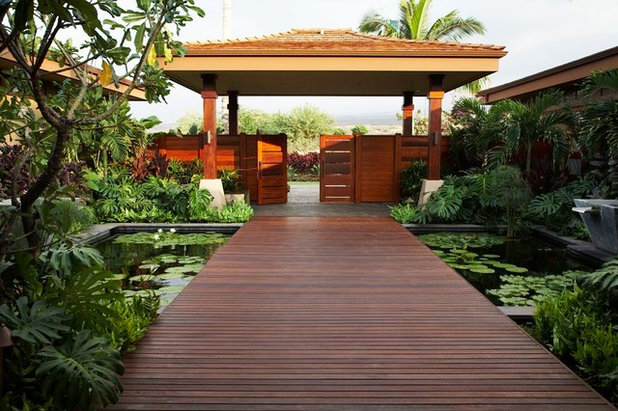
Willman Interiors / Gina Willman, ASID
A long, boardwalklike entry flanked by water sets a tropical mood as you enter the home. You don't even need to do a lot of landscaping; water plants and the hardscape and architecture do the trick.
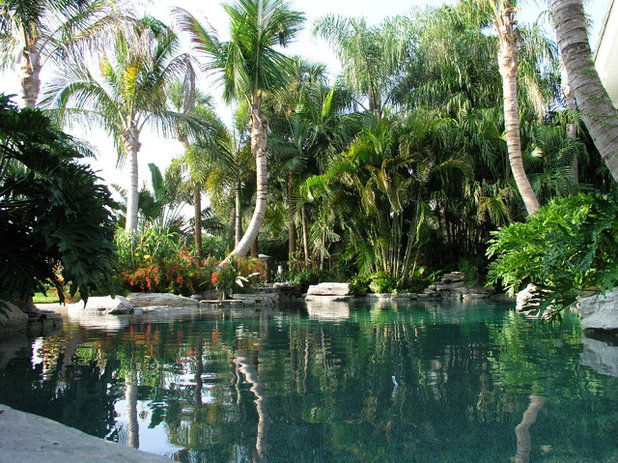
MJM Design Group, Inc.
If you've got the space and the money, go ahead and install your own tropical lagoon. The one problem is that you might never leave.
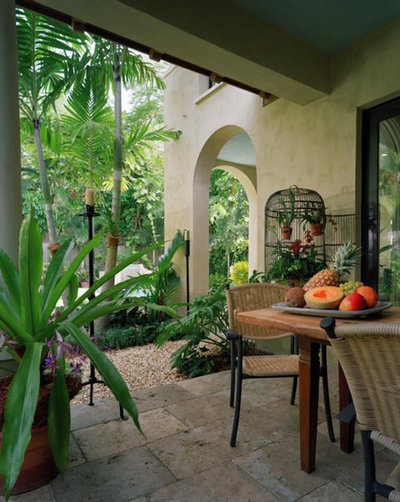
orlando comas, landscape architect.
Finish the look. A patio overlooking a tropical landscape is a cool and shady retreat as well as a great transition from house to yard. Even if your patio isn't covered, keep the look going by adding potted plants filled with foliage and bright tropical flowers, wicker or bamboo furniture, bright or rich fabrics and some fresh tropical fruit.

orlando comas, landscape architect.
Sure, you could add a tiki bar, but why not go for the tiki look over the entire patio? Rounded support beams complete the look, and the high ceiling keeps what could be a dark space bright and inviting.
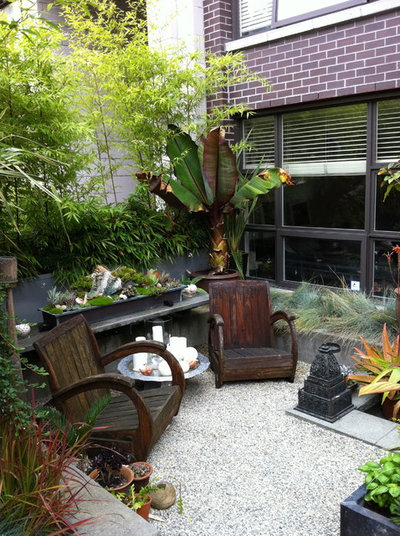
Glenna Partridge Garden Design
If your tropical garden might need to be protected in winter, consider confining it to a patio and pots. Enjoy it through the summer months, then bring it indoors.
Design tip: Add outdoor lighting to complete the mood, whether it's candles, a fire pit or subtly placed spotlights and downlights. One of the joys of the tropics is enjoying the evening under the stars, and you want to be able to do the same in your own space.
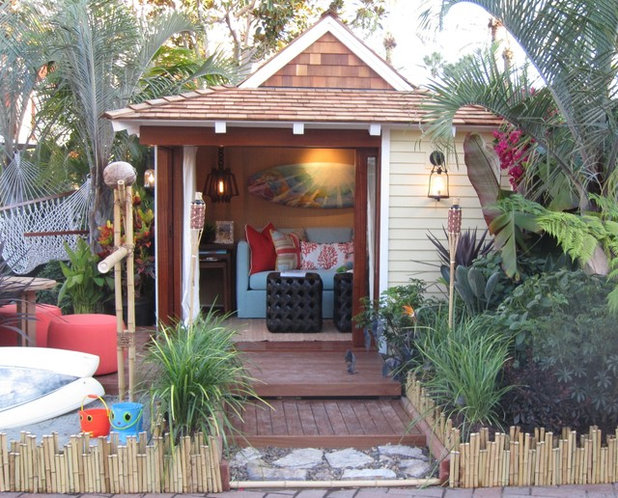
D for Design
If tropical isn't your landscape style but the look still calls you, take a tip from this playhouse. It's a miniature tropical landscape, enclosed with a miniature fence and featuring plants, bright colors, fun seating, a surfboad light and, of course, torch lights.
More:Bring the Tropics to Your Cold-Climate Garden





